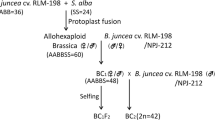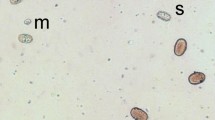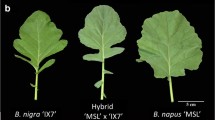Abstract
Intergeneric hybrids between Brassica juncea (2n=36), B. carinata (2n=34) and Orychophragmus violaceus (2n=24) were produced when B. juncea and B. carinata cultivars were used as female parents. The hybrids between B. juncea and O. violaceus had an intermediate morphology except for petal colour and were partially fertile. The hybrids between B. carinata and O. violaceus had a matroclinous morphology and were nearly fertile. Cytological analysis of the hybrids and their progenies gave the following results. (1) In the hybrids between B. juncea and O. violaceus, the somatic tissues of the roots, leaves and styles were mixoploid (2n=12–42), and cells with 24, 30 or 36 chromosomes were the most frequent. Based on the recorded numbers and behaviour of the mitotic and meiotic chromosomes, complete and partial separation of the parental genomes was proposed to have occurred during mitosis. This resulted in the occurrence of cells with possibly complete and incomplete complements of the parental species and cells with parental complements and some additional chromosomes from the other parent. (2) Pollen mother cells (PMCs) possibly with both parental chromosome complements, only B. juncea chromosomes or a complete B. juncea complement with additional O. violaceus chromosomes were more competitive in entering meiosis. The majority of fertile gametes were deduced to have been produced by PMCs with a B. juncea complement with or without additional O. violaceus chromosomes. (3) The progeny plants from selfed hybrids between B. juncea and O. violaceus were morphologically either of a B. juncea, hybrid or variable type. Cytologically they were grouped into six types according to the frequencies of cells with various chromosome numbers. All of the plants except 2 which constituted two types, were mixoploids, composed of cells with various chromosome numbers, mainly in a certain serial range. (4) The hybrid plants between B. carinata and O. violaceus were mixoploids with chromosome numbers in the range of 12–34, and cells with 2n=34 were the most frequent. The main categories of PMCs with 17 bivalents at metaphase I and 17 : 17 segregations at anaphase I contributed to the high fertility of the hybrids and the fact that their progeny after selfing were mainly plants with 2n=34. Somatic and meiotic separation of the parental genomes was proposed to have occurred in the hybrids between B. carinata and O. violaceus. (5) Mitotic and meiotic elimination of what could be O. violaceus chromosomes might also have contributed to the observed mitotic and meiotic cell types in the two kinds of hybrids studied. Finally, the possible mechanisms behind these cytological observations and their potential in the production of Brassica aneuploids were discussed.
Similar content being viewed by others
Author information
Authors and Affiliations
Additional information
Received: 4 February 1997/Accepted: 29 July 1997
Rights and permissions
About this article
Cite this article
Li, Z., Wu, J., Liu, Y. et al. Production and cytogenetics of the intergeneric hybrids Brassica juncea×Orychophragmus violaceus and B. carinata×O. violaceus. Theor Appl Genet 96, 251–265 (1998). https://doi.org/10.1007/s001220050734
Issue Date:
DOI: https://doi.org/10.1007/s001220050734




